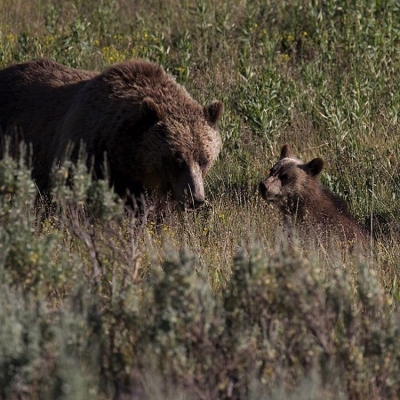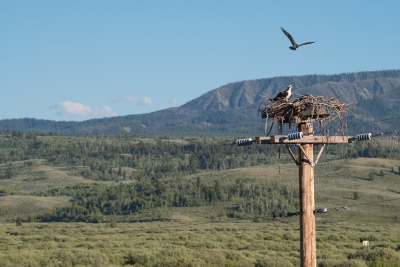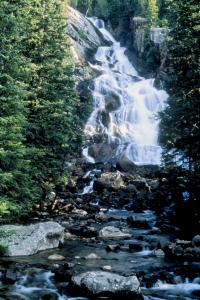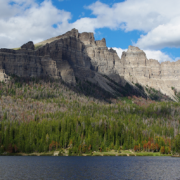The ranch is uniquely positioned within close proximity to two of the world’s most beautiful, and well-known, national parks: Grand Teton and Yellowstone. Yet there’s one, lesser-known natural resource that is literally in our backyard—Bridger-Teton National Forest. With its immense landscapes and abundant wildlife, the Bridger-Teton National Forest makes up a large part of the Greater Yellowstone ecosystem, which is the largest intact ecosystem in the 48 contiguous United States.
Top picture: Brooks Lake and Bridger Teton Rockies
The Bridger-Teton National Forest has 3.4 million acres, borders Grand Teton National Park and encircles the National Elk Refuge. It contains three nationally-dedicated wilderness areas, including the Bridger Wilderness, the Gros Venture Wilderness, and the Teton Wilderness.
All of this makes for some of the most splendid hiking, biking, horseback riding, and rock climbing anywhere. (Not to mention winter activities in winter.) Here are some of the activities and features you can take advantage of in the Bridger-Teton National Forest during your stay at the ranch.

Wildlife
Bridger-Teton contains a diverse amount of wildlife during summer, including bald eagles, coyotes, sandhill cranes, trumpeter swans, and of course, elk. During winter, wildlife may also include moose, mule deer, and bighorn sheep. Although it’s most known for mammalian wildlife, Bridger-Teton provides refuge for more than 355 species of birds.
View the best wildlife viewing sites here.
Hiking
Bridger-Teton has 34 designated trailheads with more than 2,200 miles of trails that vary in difficulty from family day-hikers to hard core wilderness enthusiasts.
View list of Forest Service hiking trails in Bridger-Teton here.
Biking
Of the trails in Bridger-Teton, many are multiple use, meaning they allow hiking, biking, and horseback riding. On multiple use trails, the National Forest Service rule is “wheels yield to heels.” Use our bikes, rent some nearby, or bring your own.
View the list of bike trails here.
Horseback Riding
As a ranch, we have a large selection of horses for riding in the many beautiful surrounding areas, and they are available for solo or guided adventures in blocks of two hours or a half day. We also provide lessons, for those of you who have always wanted to ride, but never had the chance to get started!
View our horseback riding rates here.
View the list of horseback trails in Bridger-Teton National Forest here.
Picnicking
Designated picnic areas may provide tables, fire pits, water supply, and/or restrooms. Remember the food storage order is in effect between March 1 – Dec. 1 each year, which includes preventative measures to keep bears from finding and eating food, as well as protecting the safety of forest visitors. We’re happy to provide a lunch you can take along, just let us know in advance, and whether you need to meet food storage requirements (depending on your path and destination).
View the list of picnic sites (which include their individual amenities) here.
It is also encouraged to review food storage guidelines, which can be found here.

Climbing
Wyoming boasts rock, alpine, and ice climbing, and many great climbing sites can be found within or adjacent to Bridger-Teton, including a large number of routes adjacent to the Bridger Wilderness Area.
Use this map to search and see details about routes.
Fishing
Three types of fishing are available from dozens of locations within Bridger-Teton. There are over two dozen river and stream fishing spots recommended by the Forest Service, for the fly enthusiasts we typically host. For those who bring or rent a marine craft, there is boat or lake fishing, which can be accessed from a network of docks within the Bridger-Teton National Forest. In the winter season, ice fishing is also available. Remember that fishing requires a permit.
This Forest Service site provides lists of all recommended fishing sites with their amenities here.
Swimming
There are a variety of beaches and swimming areas within Bridger-Teton suitable for the hottest months. here is also one developed, concrete hot springs pool, the Granite Hot Springs Pool, situated along the Granite Creek among the huge spruce, fir, and pine forest. It is available during summer (usually May 20 – Oct 31) or winter (Dec 6th – Apr 3rd) seasons for a small fee (although access during winter months is limited to visitors on snowmobile, skis, or fat bikes). Call ahead to verify area status.
View swimming areas, including amenities, fees, and hours of operation, here.
Boating
With 34 non-motorized and 17 motorized boating areas, Bridger-Teton is a water wilderness paradise. The Snake River Canyon alone is highly sought after for kayaking, rafting, and fishing due to its crystal clear waters, unique geology, beautiful scenery, world-class fishing, and for the adventurous, the experience of shooting some wild water rapids. However, there are many other waterways to explore in Bridger-Teton.
View non-motorized boating and launch sites here.
View motorized boating and launch sites here.

Forest Product Gathering
In addition to recreation, there are many types of forest products (aside from fishing) that can be gathered in Bridger-Teton. Everything from firewood, pine cones, mushrooms, live transplants of shrubs, grasses, moss and lichens, herbs, foliage, and more can be gathered for a small fee and with a permit.
For permits, fees, and other permit questions, visit the Forest Product Permit Information page here.
There are many other activities available in Bridger-Teton National Forest. You can view many of them on the Forest Service website, but one neat way to explore Bridger-Teton (and other National Forests) is through their interactive map, which makes it easy to locate activities and amenities based on the geographic location you want to explore.
When you are at the ranch for your next great western adventure, we’ll be here to help you in comfort and style. Our cabins and chalets have been recently renovated to provide luxury accommodations while embracing a working ranch experience. Guests enjoy breakfast, but whether or not you chose to stay with us overnight, you are also welcome to join us for our Prairie to Plate gourmet lunch and dinner. (Reservations requested for dinner.) Let your stay with us become the vacation you’ll never forget.










































